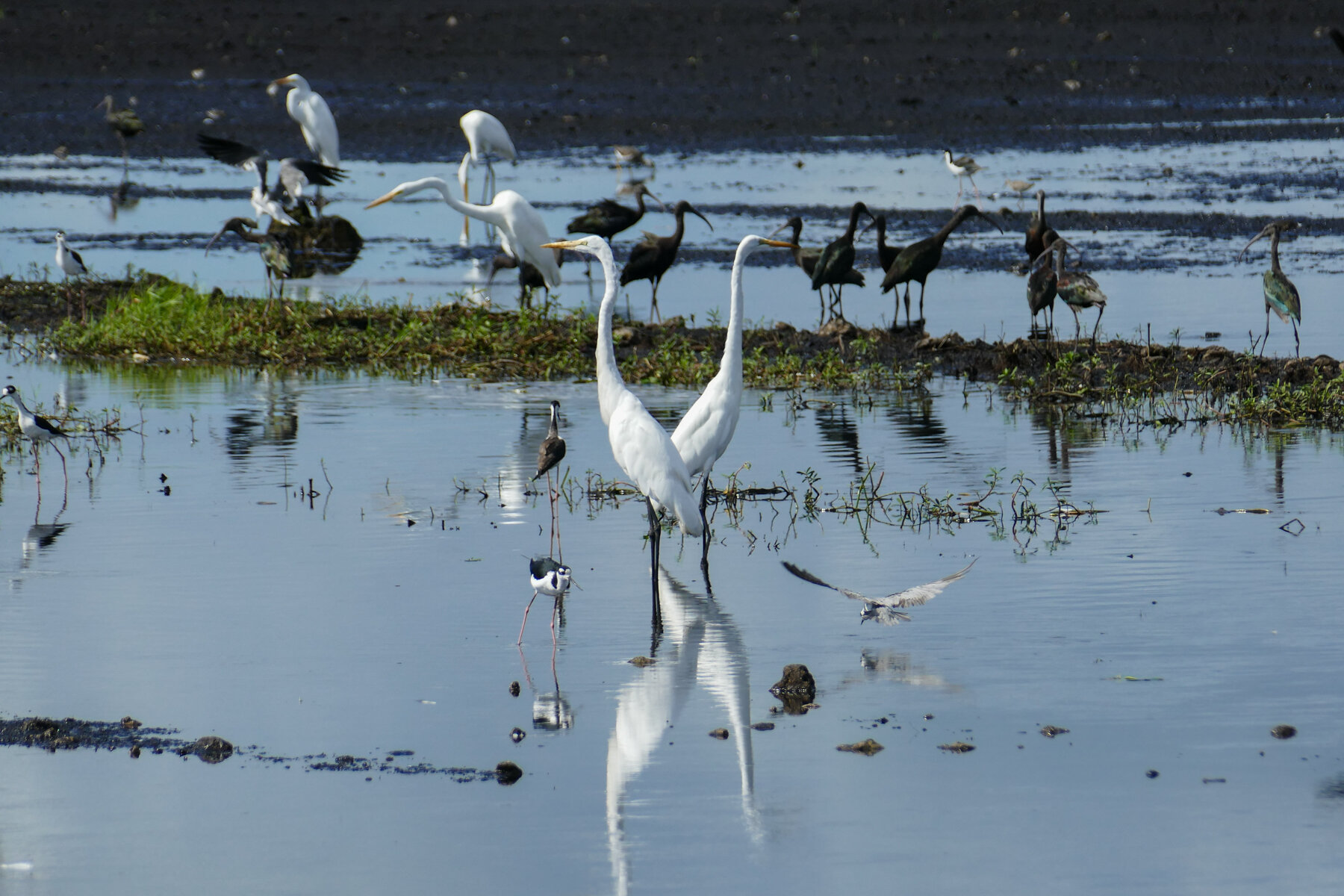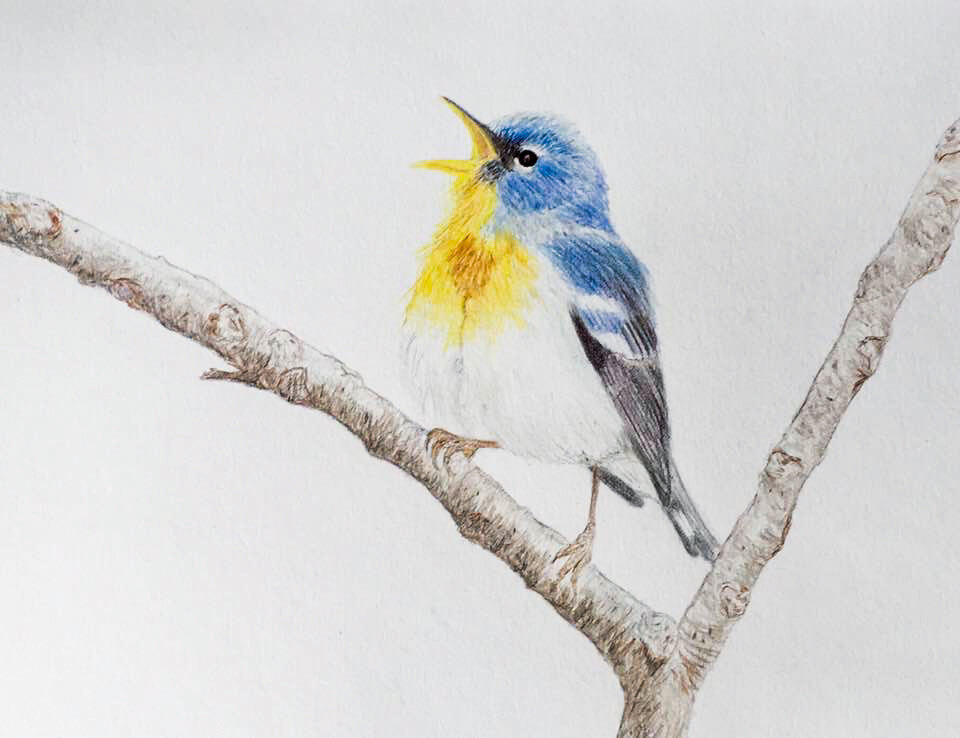Fall Migration – My Favorite Time of Year to Bird in South Florida
All illustrations by Roxanne Featherly.
South Florida becomes an exciting place to bird starting in late July when shorebirds from the Arctic Tundra, Great Plains and New England beaches make their migration south for their winter grounds. One of my favorite birding spots this time of year are fields near the Homestead Miami Speedway at the intersection of SW 132nd Ave. and North Canal Path Road (C-103 canal). During recent visits in late July and early August, I saw Black-Necked Stilts, Killdeer, Greater Yellowlegs, and Least, Pectoral, Stilt, Semi-Palmated and Solitary sandpipers. Herons, egrets, ibis, shrikes, grackles and swallows (Barn and Cliff) rounded out the mix.
Killdeer
Another favorite spot among birders is the Palm Beach Agricultural Farms that can attract large numbers of shorebirds. In addition to the list of shorebirds previously mentioned, one can see Ruddy Turnstones, Long-billed Dowitchers, Black-bellied Plovers, Dunlin, and Buff-breasted, Upland and White-rumped Sandpipers. A good pair of binoculars (10 x 40 for example) plus a spotting scope is needed to see many of these shorebirds that feed way back in the grassy sod fields. If you’re lucky, as I was on a day trip last month, you may see an American Golden Plover. Another year someone found and photographed a rare Pacific Golden Plover! That was an exciting bird chase.
Also at this time of year, waders are returning from their summer breeding grounds. Who doesn’t love Great Blue, Little Blue, Tri-colored and Green Herons? It’s a great time to watch these birds fish and feed. Green Cay and Wakodahatchee Wetlands offer superb venues for getting up close and personal still and video photography of your favorite wading birds.
Above: Palm Beach Agricultural Fields. Images by Andrea Diamond Kanter.
Although I love to study and observe many families of birds in the field (ducks, hawks and gulls), songbird migration seems to be every birder’s favorite. It stretches from mid-July through the end of November, or when the first cold front arrives. This marks the time when some migratory birds make their winter homes in South Florida and others continue their migration to Central and South America, and the Caribbean. Yellow-throated Warblers, Black and White Warblers, Northern Parula, and American Redstarts make the first wave. Also, look for Red-eyed Vireos which begin to trickle southward at this time.
As fall migration revs up in mid-August and September, be on the lookout for Prothonotary, Worm-eating and Cerulean Warblers and Yellow-billed Cuckoos. At the time of this writing, birders are hearing and seeing Alder Flycatchers before the entrance of Everglades National Park (L-31 canal road, Lucky Hammock and the Annex; officially known as the Frog Pond Water Management area).
In September look for Summer and Scarlet Tanagers, Rose-breasted Grosbeak, Chestnut-sided, Blackburnian, Magnolia and Black-throated Green Warblers.
Another hallmark of South Florida birding in the fall is raptor migration. The Florida Keys Hawkwatch at Curry Hammock regularly produces a breathtaking show of Peregrine Falcon. For a couple of weeks in October, the Hawkwatch can tally up to 500 Peregrines in a single day. Osprey, Northern Harrier, Merlin, Cooper’s Hawk, Broad-winged Hawk, Swainson’s Hawk and American Kestral also fly-by in impressive numbers.
American Kestral
I enjoy birding Florida’s wild and scruffy places, but Miami provides some of the best suburban birding year-round. There are many parks and gardens to explore. My local favorites are A.D. Barnes, Kendale Lakes and Kendall Indian Hammocks Park in southwest Miami, and, on the eastern boundaries, Crandon Beach Park and gardens, Bill Baggs State Park, Matheson Hammock Park and Palmetto Bay Village Center (PBVC), my local neighborhood patch. For these and many more locales in Miami-Dade, Broward, Palm Beach and Monroe County, go to www.tropicalaudubon.org. Click on the menu, scroll down to ‘Birds’ and click. Under this ‘Birds’ heading, you will find a bird load of information on topics such as South Florida Birds, Birding Locations and more. Regular sightings of birds seen can be found on Tropical Audubon Society’s Facebook page and the Florida Birding and Rarities Facebook Group.
Another excellent source to find out what species are moving through South Florida during fall migration is The Cape Florida Bird Banding blog. Go to capefloridabandingstation.wordpress.com. You can read daily reports from August 15 through the end of October/beginning of November when a hearty group of volunteers catch and band migrating birds. They record and log vital information that allows researchers to identify individual birds, shed light on breeding and wintering sites, track seasonal movements and migration patterns, and determine how long birds live.
Lastly, I would be amiss if I did not mention eBird, The Cornell Lab of Ornithology’s major Citizen Science project. It’s an in-depth tool to find birds in your area as well as around the world. You can keep track of your bird lists, observations, notes, photos and sound recordings. It’s your personal contribution to science and conservation. Go to www.ebird.org to get started.
Whatever your approach to birding, keep it simple. You can start by looking for birds in your backyard and around your neighborhood. Most importantly, do it, have fun, and enjoy the outdoors!











